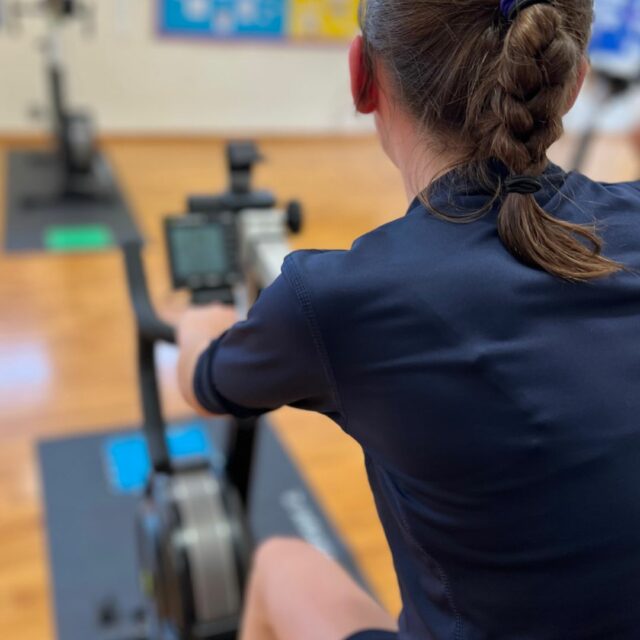Year 12 Biologists visited the Babraham’s Institute in Cambridge to complete a lab project. The institute’s research is primarily on aging and specialises in immunology, cell signalling and epigenetics. The visit was an opportunity to meet in small groups with research scientists and complete a hands-on project. Some of our students give their insights, below.
Bethan M
“My practical project was Scanning Electron Microscope imaging. We began by preparing some of our own eyebrow hairs by soaking them in 100% acetone for 10 minutes to remove any water or oil as this can obstruct the electron beam, resulting in a lower clarity image. We then placed sticky carbon dots on aluminium sample pins and mounted the hairs on to these. We used carbon dots, as carbon is a good conductor of electricity, so the electrons are absorbed resulting in a clearer image. After, we transferred the sample to the sputter coater and coated it with a 5mm layer of platinum which inhibits charging, improving the image quality. We then repeated this procedure with each person in my group choosing a different face mask material, I used a surgical facemask and divided it into the 3 different layers, and then we began transferring them into the SEM for imaging. When transferring the samples, we had to place them in an airlock so that the SEM could create the vacuum and reach the air pressure required.
The hairs were extremely interesting as you were able to see the hair cells at the root which were being pushed upwards and being packed together to form the hair. You were also very easily able to see the hair shaft and therefore you could tell whether the hair was healthy or not. We also were able to compare hairs with and without makeup and dead skin cells. We compared a reusable facemask, a single use surgical facemask and a single use N95/FFP2 mask. The reusable face mask was the least effective as the fibres were only loosely woven and through every single gap, thousands of pathogens could pass through. The single use surgical face mask was much better as it consisted of 3 layers with interlocking fibres in different directions, preventing as many pathogens to pass through. The best was the single use N95/FFP2 mask as it consisted of 5 thicker layers with even smaller gaps between layers. At the end we looked at some other samples that had been prepared for us. We were able to view the mouldy sections of blue cheese where you could see bacteria and fungal spores with hyphae. We also looked at a mosquito and looked in detail at the compound eyes.
Overall, I loved the experience as I have wanted to use an SEM since we learnt about them and I loved seeing the 3D images produced and being able to control the microscope was a really fun and interesting experience.”
Siona M
“My practical project was in the gene targeting facility. Gene targeting allows us to create genetically modified organisms that can perform a useful function or express a specific phenotype. The research for gene targeting at Babraham’s uses mouse embryos: these embryos are received from a specific type of black mouse and require a lot of licensing to get your hands on! The facility uses CRISPR technology to target the three specific areas of research at Babraham’s: epigenetics, immunology, and protein signalling.
We created our solutions used to edit the DNA out of a Cas-9 protein and different SgRNA proteins, for which I chose to use the epigenetics and immunology proteins. I really enjoyed using the special pipettes as they were super precise and quick to use. Then we visited where the embryos are kept at specific temperatures, humidity, and CO2 conditions. My favourite part was the insertion of our Cas-9 solutions into the embryos. There were three ways to do this: electrically shocking the embryos in the solution to stimulate them to divide into more cells with that altered genome, using a suction tube under a microscope to keep a single embryo in place and use a micro-needle to pierce the membrane (carefully!) to insert the solution or use a virus that can pass through the membrane as a vector to transfer genetic information. We got to use the micro-needle on some non-viable embryos (so we did not waste any useful specimens). The embryos would then be implanted into a surrogate mother and the GM mice would be born. Once the mice are ready, three samples are taken from each ear of each mouse to analyse the genome using PCR. We got our own samples and created a master mix solution by adding a gel to the sample, incubating to extract the DNA, then adding that solution to the master mix. This was put into a PCR (polymerase chain reaction) machine which makes many copies of small sections of the mice DNA. After this, we pipetted the solution into an Agarose jelly. When left the right amount of time the gel will show how successful the PCR reaction was, showing the genomes of the mice. If the genome is smaller, it will travel quite far and if the genome is bigger, it will not, almost like chromatography. PCR test results can then be analysed to see which genomes are present in the mice and if any have been taken away, replaced, or added.
I really enjoyed this practical project as it helped to learn about the potential of genetic medicine and furthered my interest into veterinary medicine.”
Ashani P
“My practical project was ‘how to build a complex organism’ and detecting mutations in DNA. We started by observing fruit flies with genes displaying different phenotypes and mutations of those genes in other fruit flies. I observed physical characteristics including wings and eye colour using microscopy. One sample had fruit flies containing white genes which code for the red pigment in their eyes. The other sample had a mutation in this white gene causing the red pigment to be unobservable in their eyes. In another sample we observed how the vestigial gene codes for the formation of the fruit fly’s wings. We compared this to fruit flies which had a deletion of a base in the vestigial gene causing them to be wingless. We also saw how GFP (green fluorescent protein) can be used to observe which proteins are present and which aren’t due to mutation.
The second part of the practical activity involved extracting the specific genes we saw in the phenotypes (white gene and vestigial gene) from the DNA. We were told that the DNA is extracted using soap (to break the cell membrane), salt (to bring the DNA together) and alcohol (to precipitate the DNA). The number of copies of the genes are then replicated by PCR (polymerase chain reaction which is also used for COVID-19 testing) to amplify the regions of interest. We then used a process called DNA electrophoresis to separate the different types of genes based on their size (number of base pairs) and their negative charge. To start this process, we transferred the PCR products onto an electrophoresis gel using a technique called reverse pipetting. We ran a current through the gel. This caused the PCR products to move through the gel from the negative charge at the cathode to the positive charge at the anode. The shorter gene bands moved the furthest, closer to the positive charge. Finally, we used a gel imaging device with a camera to observe and identify the different separated genes. The white gene in the fruit flies contained 5,500 base pairs, the vestigial gene contained 3,500 base pairs and moved further and the GFP gene contained 600 and moved the furthest.”
Eve L
“My practical project was entitled ‘working with worms – a model organism for ageing and disease’. The aim of the project was to study protein aggregation in a type of nematode called C. Elegans. These worms are perfect for studying ageing due to their transparency – so you can see the fluorescent tag, their short lifespan – of around two weeks, along with the fact that they are Hermaphrodites – meaning they are capable of self fertilisation.
The protein already known to aggregate with age is PAB-1 (which binds to the poly(A) tail of the mRNA) and so I began my project by comparing the distribution of this in worms three days and 10 days old. As we age, the ability of protein synthesis and protein folding can deteriorate, causing deposits of these large insoluble protein clumps. We used a technique called fluorescence microscopy where we filled a Petri dish with worms and a genetic construct which importantly includes a promoter that is able to initiate transcription. Once we had located and focused the microscope on a worm, we could turn the light off and see the clumps of protein moving around as they were expressed by a red fluorescent tag called tagRFP. This allowed us to categorise the worms according to whether aggregates where in the posterior or anterior bulbs in the head region. A challenge was ensuring that you didn’t lose your worms on the other side of the Petri dish whilst zooming into the one you were focusing on! Results, as expected, concluded that the older worms were more likely to have protein puncta in both the posterior and anterior bulbs as result of the natural protein accumulation which occurs with ageing.
After this, I focused my attention to how worms are maintained within the lab. We used a pick heated with an alcohol lamp and scraped on a strain of E-coil bacteria in order to transfer worms from one Petri dish to another. It was important not to pierce the agar and after squashing one of my worms, I had a very interesting discussion about the ethics of research with a technician. I was able to identify the different stages in the lifecycle of a C. Elegan, and the behavioural changes associated with this. For me, the most exciting stage to learn about was the Dauer stage which is where the worms are confluent, begin to become starved and migrate to the outskirts of the bacterial ring. They also release large quantities of eggs which can be identified in the pictures I took.
I thoroughly enjoyed this practical project and it was a really interesting insight into how research with worms is one of the first steps towards developing therapeutic treatments for neurodegenerative and age-related diseases, such as Alzheimer’s and Parkinson’s. It raised many questions about what underpins these diseases on a molecular basis and subsequently about their ability to be prevented.”
Other Biology Spring news
Tanisha M has come runner up in an essay competition where she wrote a piece entitled: ‘To what extent is injecting Human Growth Hormone into our bodies to slow down ageing safe’
Dissection news! Dissection club started this Spring Term with a locust dissection. The Year 12s have been dissecting fish heads and examining their gills underneath a microscope.
Year 12 have been practising their presentation skills by presenting to their peers on topics of interest to them: genetic disorders to blood and its features.




